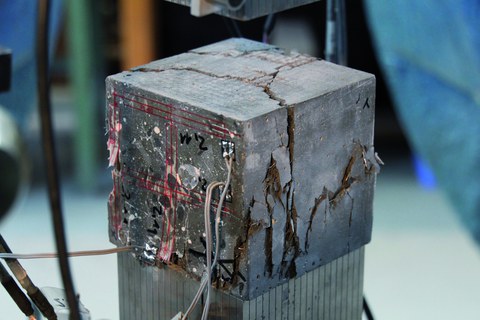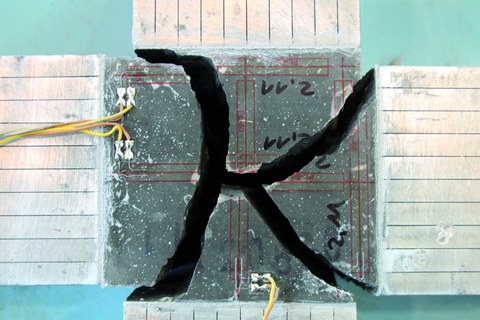Multiaxial strength of UHPC
Table of contents
Project data
| Titel | Title Versuchstechnische Ermittlung und mathematische Beschreibung der mehraxialen Festigkeit von Ultra-Hochfestem Beton | Experimental determination and mathematical description of the multiaxial strength of Ultra-High Performance Concrete Förderer | Funding Deutsche Forschungsgemeinschaft (DFG) / SPP 1182 Zeitraum | Period 11.2005 – 06.2012 Leiter | Project Manager Prof. Dr.-Ing. Dr.-Ing. E.h. Manfred Curbach Bearbeiter | Contributor Dr.-Ing. Kerstin Speck |
Report in the yearbook 2012
Multiaxial Strength of UHPC

UHPC with fibres under uniaxial compression
A strong cement matrix, high strength aggregates and a dense structure ensure the potential of ultra-high performance concrete (UHPC): high compressive strength and high durability. At the same time, in comparison to the ordinary concrete it has a more brittle behaviour. Variable stress conditions affect the strength differently. If one want to design with UHPC, all these aspects must be taken into account. Many loading situations lead in concrete structures to a multi-axial stress state, which is attributed from the calculation models as uniaxial stress typically. Therefore, the capacity of UHPC under multi-axial stress experimentally was determined with respect to the uniaxial compressive stress and in comparison to the strength of normal concrete.
Under bi- and triaxial compressive stress the strength increases in comparison to uniaxial loading less than in the case of normal concrete. Partially, under the same pressure from two sides no increase in strength was determined. A strength increase of 10 % in the calculation of pressure nodes in truss models can therefore not be used for UHPC. Under biaxial tensile stress, the strength has the same value as for the case of a uniaxial stress. This behaviour is similarly with normal concrete. This strength occurs in the area of compression-tension until the point where the compression and tension are equal in absolute values. Thereafter, the tensile strength decreases in proportion to the increasing of the compression, contrary to the behaviour of normal concrete.
Through adding high-strength steel fibres, one is trying to minimize the brittle behaviour of UHPC. By adding up to 2.5 volume percent of fibres, the tensile strength can be increased approximately about 30 %. Under biaxial compression, the fibres offer an increase of maximum 10 %. Similar redistribution possibilities and strength increase under biaxial compression result when coarse aggregates are used in comparison with the case when they are missing. On the stress-strain behaviour the fibres have almost no effect as the fibre content is less than the minimum reinforcement content. Only by a few stress combinations we could determine differences in the direction of lateral strain. A quasi-ductile behaviour as normal concrete shows occurs only under triaxial compression and is more pronounced the higher the lateral pressure is.
Report in the yearbook 2011
Multiaxial Strength of UHPC

Failure under biaxial tensile load
Ultra-high performance concrete (UHPC) has many advantages such as high compressive strength and high stiffness, high density and therefore high durability. UHPC also has disadvantages that must be considered in construction with UHPC. For instance, the tensile strength does not increase at the same rate as the compressive strength, which results in a generally more brittle failure. Even the dense structure leads to a sudden failure at a fire attack. These disadvantages are partially compensated by the addition of steel and/or polypropylene fibres.
To absorb tensile forces in the structural element, reinforcement is inserted into the concrete. Often, however, the tensile strength of concrete is still decisive for the load-bearing capacity, as in the reinforcement anchorage, the transfer of shear forces or the load transfer into dowels or shear connectors. In general, multi-axial compressiontension loads are relevant for dimensioning. Therefore, the load capacity of UHPC was not just investigated under bi- and triaxial compressive stress, but it was determined experimentally under combined compression-tension and tensiontension loads in the third phase of the project.
The experiments were carried out in the triaxial testing machine in the Otto-Mohr Laboratory. For the introduction of tensile forces special tensionload brushes were developed that were manufactured in contrast to the existing high-strength steel compression-load brushes made of aluminium. They have shorter and less bristles that enhance the durability of the glued joint between the concrete and load application brush at similar stiffness conditions.
When biaxial tension occurs in the range between the uniaxial tension and pure shear (tensile force equal to compressive force), the tolerable tensile stress lies at the level of the uniaxial tensile strength and then the tolerable tensile stress decreases almost linearly with stress ratios up to uniaxial compression. UHPC behaves almost linear-elastic until failure. This behaviour is not qualitatively changed significantly by the addition of up to 2.5 % by volume steel fibres; only the uniaxial tensile strength was increased by about 30 %.
The material behaviour of UHPC under multiaxial states of stress differs significantly from the behaviour of normal concrete, so that the renowned design approaches are not applicable to UHPC. The description of this behaviour is necessary for the use of ultra-high strength concrete, as the multi-axial strength is often safety relevant.
Report in the yearbook 2009
Multiaxial Strength of UHPC
Compared to normal concrete, UHPC, or ultra-high performance concrete, possesses up to five times more compressive strength; a denser structure; increased frost and chemical resistance, as well as overall durability. Contrary to the better performance of UHPC, it behaves in a more brittle manner than normal concrete and tensile strength does not increase proportionaly to the compressive strength. The strength increase from multiaxial loading—related to uniaxial strength—is less than that for normal concrete. As part of a German Research Foundation (Deutsche Forschungsgemeinschaft, DFG) priority program, the Institute of Concrete Structures at the Technische Universität Dresden examined the multiaxial strength of UHPC to insure the stability of structures comprised of this high performance building material.
Experiments were conducted in a triaxial testing machine which allows for compressive and tensile stresses to be applied to specimens independently. The load application takes place through special pressure plates, referred to as loading brushes. These ensure a homogenous stress distribution in specimens and allow for the determination of the concrete specimens’ deformation, even when fully encased (i. e., surrounded) by the loading brushes.
These experiments confirmed that multiaxial strength – relative to uniaxial strength – is considerably less than that of normal concrete. While normal concrete exhibits higher strength levels under biaxial compression than under uniaxial compression, using the same stress ratios for fiber-free UHPC shows no increase in strength relative to its uniaxial strength. An increase in strength can be insured by the addition of high-strength steel microfibers, although these levels are still considerably less than values for normal concrete. Despite the addition of these steel fibers in an amount of up to 2.5 % by volume, UHPC behaves in a very brittle manner under uniaxial and biaxial compression. Behavior is increasingly ductile with increasing levels of compression under triaxial loading and, thereby, failure is indicated earlier. More importantly, findings indicate that both the maximum absorbable stress and resulting strains are independent of the load path applied to specimens.
Future research undertaken in the course of this project will utilize recent knowledge acquired about biaxial and triaxial behavior under compressive stress and will be complemented by examinations of biaxial compression-tension- or tension-tension-behavior. Knowledge obtained from these experiments will be used in the ongoing formulation of material laws fostering the realistic design of components comprised of UHPC.
